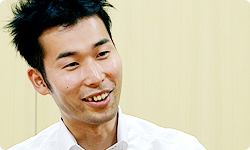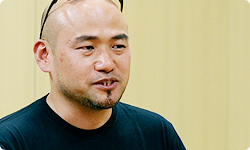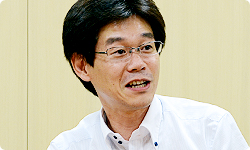What happened within PlatinumGames that led to your bringing the project to Nintendo a second time? I’m assuming that it wasn’t so easy for you to rewrite the plan.
That’s right. As far as PlatinumGames was concerned, the project was all about the characters, so we stopped the whole project for a while, because we knew it would be difficult if we couldn’t get permission there. Kamiya was actually working on a different project for a while.
Is that so?
But there were a lot of factors with that new project that eventually led us shelving it. So when Kamiya and I discussed what we should do next, he pushed me into it saying “I really do want to do that other project.”
Well, I mean, I can’t just come up with one project right after the other!
(laughs)
After reviewing various factors, we left the gameplay we’d originally proposed as-is, and made up a demo on a PC replacing the existing characters with superheroes, and brought it to Nintendo.
Did you have character images for the superheroes that became the final main characters at that point?
No, the visuals we had then were quite different.
When the project first started, the characters were more like Viewtiful Joe11, like the dark superheroes in US comic books. I liked that art a lot, and I did think we could go with it.11. Viewtiful Joe: A side-scrolling action game released by Capcom for the Nintendo GameCube in Japan in June 2003, and in Europe in October of the same year. The game featured unique “VFX Action” that let the user control time and space, and unique American comic book-style graphics. It was made into a series and a TV anime in Japan.
Right.
Matsushita-san loves action games, so I showed it to him, and asked, “This project will be really interesting. Won’t you work on it with me?” And right away, he said something like “The images are too dark. Elementary and middle school kids won’t go for this.”
Did you say that right away, Matsushita-san?
I did say that. (laughs). I was convinced we had to change it. But I couldn’t just say “This looks way too much like a dark comic book, so this is no good” to the guy who already made a game in that style, could I!?

That would be quite rude, indeed! (laughs)
I’d heard that the folks at PlatinumGames were very particular, so we had a lot of discussion within the company about how we could get it across to them, and whether we should just prioritise PlatinumGames’ concept and move forward with it.
But in the end, it was decided that in order to have it reach as many people as possible, you would need to change the visuals.
That’s right. And I figured, “We just have to be frank with them and ask.”
How did you react, Kamiya-san?
When I heard that, to be honest, I thought, “I knew this was coming.” I even admitted myself that it would be going into a bit too much of a niche market if we kept it that way. But I couldn’t decide just what would make it better. And then Inaba told me about Nintendo’s suggestions...

(Turning to Kamiya-san) You’re saying that like you agreed with everything right away, but we argued quite a bit, didn’t we?
Oh I complained to Inaba like a child.
(laughs)
And then Inaba-san, who has a long relationship with Kamiya-san, saw that and understood: “Kamiya got hit where it hurts.”
But the problem with Kamiya’s personality is that he’s not much different from when he’s actually protesting something for a reason.
It’s hard to tell with him?
Right. He starts moving on a project like, “Well okay. If the great and mighty producer says that, I guess I don’t have any other choice.”
(laughs)
But the visuals that we ended up getting back after putting the ball in their court to change them were a bit different from what we’d been envisioning. It’s so like Kamiya-san not to just say “I changed them just how you asked.”
The ‘realistic figure, realistic toys’ concept was born then. The look is both pop and realistic at the same time.
It does have a uniqueness that’s not around a whole lot, and it also has the benefit of being cheerful and pop.
There’s still a distinctive Kamiya style to it, but most of the unnecessary darkness was removed, and I think the balance turned out very well.
At that point, all that was left was to make it, right? After all, the basic framework of the game was already outlined clearly in the project plan.
That’s true. As we mentioned earlier, the foundation of the game, which used Unite Morph wasn’t changed much from the very beginning. The player is bringing an army of many superheroes with him or her and can use Unite Morph to transform the army into one large character and use it to solve problems on the map. There are all kinds of Unite Morphs, so you decide how to solve each problem as you play. You can use and select all sorts of different weapons.
So you already had all of that decided.
Yes. At Nintendo, the first thing we wanted to do was get all the game features planned out, but they wouldn’t show us much at the beginning. Kamiya-san was more interested in building the game world, so he kept having all these ideas like, “I want to do this! I want to do that!”

Oh, right. When I met with you back then, Yamagami-san, I remember asking how the gameplay was feeling more than a few times.
Right. We knew the art style and how the gameplay would go, but making the game world was the only part that was moving ahead, and we didn’t know details about what’s going to be fun about it and all the other important aspects. So I started to get worried. That situation lasted for a long time.
In terms of all that, wasn’t it until we got into 2013 when we finally sealed the gameplay?
At around last year’s E312 you were able to play it normally, but it wasn’t until this year that we were able to nail down the details. 12. E3 refers to the Electronic Entertainment Expo, an annual video game trade show held in Los Angeles. E3 2012 was a three-day event held on June 5th to 7th, 2012.
That’s right. I feel like we kept changing things slowly. Every time we got close to a deadline, we were like “We can’t leave it like this!” and kept changing things a little bit at a time.
Are deadlines a source of energy for you, Kamiya-san?
Yes. It’s only when I get to the point that my teeth are chattering and I’m like “This is bad!” that I can really think about things.
(laughs)
(turning to Kamiya-san) Maybe I should have your teeth pulled?
(laughs)
But I really wasn’t satisfied with things at the point of last year’s E3. It wasn’t really fun yet. We had solid art, and it had a uniqueness with the game having a lot of characters, but we didn’t really have the most important part, which was how the gameplay would be.
© 2024 Nintendo.